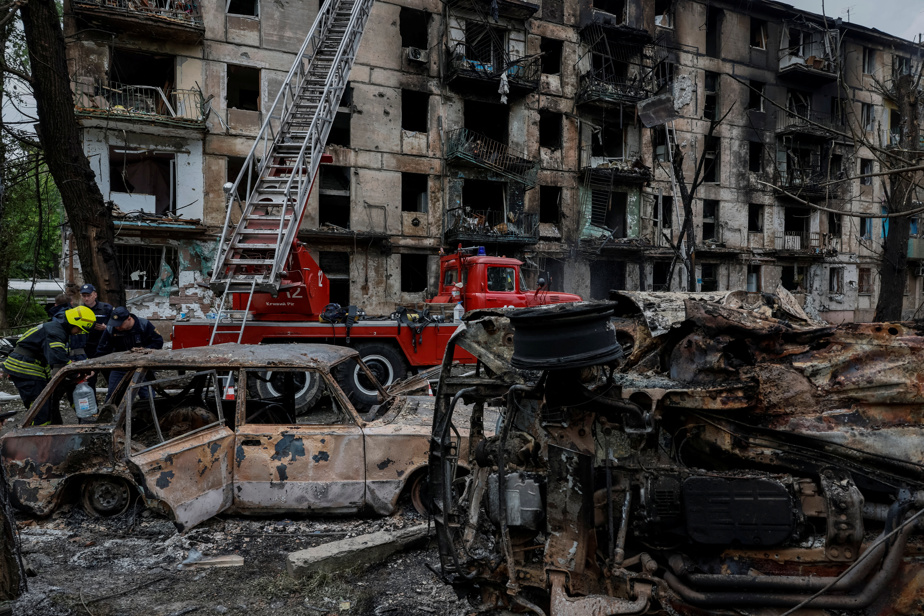(Kyiv) Russian strikes on the industrial city of Kryvyi Rig in central Ukraine killed at least 11 people before dawn on Tuesday, as Russia continued its tactic of night bombardments of the country in the midst of the Ukrainian counter-offensive .
WHAT THERE IS TO KNOW
- Ukraine inquired from Australia about the status of about 40 F-18 fighters withdrawn from service and stored at a base near Sydney;
- The German Minister of Defense warned that he could not replace all the tanks supplied by his country to Ukraine and put out of use during the fighting;
- Russia on Tuesday raised the death toll from flooding in areas it controls in southern Ukraine to 17;
- The Russian army claimed to have captured for the first time on the front in Ukraine German-made Leopard tanks and American-made Bradley armored vehicles.
Kyiv for its part indicated on Monday evening that its offensive in the south and east to liberate territories occupied by Russia was “difficult”, but was progressing with the resumption of a handful of villages in the south of the country.
Moscow, which has been saying for days that it has been repelling Ukrainian attacks, claimed for the first time on Tuesday the capture of German Leopard tanks and American Bradley armored vehicles, vehicles supplied by the West so that Kyiv could carry out its vast counter-offensive.
In Kryvyi Rig, the birthplace of Ukrainian President Volodymyr Zelensky located in the Dnipropetrovsk region, a “massive missile attack” hit several places in the city, including a residential building, according to local authorities.
“A five-storey building was damaged,” the Dnipropetrovsk regional administration reported on Telegram.

PHOTO ANDRIY DUBCHAK, ASSOCIATED PRESS
Kryvyi Rig, June 13, 2023
According to regional governor Serguiï Lyssak, the death toll is eleven, after the discovery of a last body under rubble.
The previous assessment reported 10 dead, one person under the rubble, 28 injured, including 12 hospitalized.
The regional administration published a photo of the building badly damaged and blackened by flames, smoke billowing from the floors.
In Kyiv, the military administration also reported nightly “cruise missile” strikes, while assuring that “all enemy targets in the airspace around Kyiv have been detected and successfully destroyed”.

PHOTO ANATOLII STEPANOV, FRANCE-PRESSE AGENCY
Bakhmut region, June 13, 2023
“Seven villages liberated”
Monday evening, President Zelensky assured that the current offensive against Russian troops was “difficult”, but “progressing”.
“The fighting is tough, but we are making progress,” he said in his daily address, assuring that “enemy casualties are exactly at the level we need.”
“The weather is not favorable – the rain makes our task more difficult – but the strength of our soldiers is giving good results”, he added, welcoming the return of the Ukrainian flag to “newly liberated territories”.
Ukrainian authorities said Monday evening they had retaken seven villages after more than a week of fighting.
Several localities were notably taken over in the region of Zaporijjia (south), said Deputy Minister of Defense Ganna Maliar on Telegram, estimating at 90 km2 the area of the territory taken over by the Ukrainians.
The Ministry of Defense also said on Monday that it had “advanced 250 to 700 meters” around the devastated city of Bakhmout (east), whose capture was claimed in May by Russia.
Moscow for its part claimed to have repelled the Ukrainian attacks in the Donetsk region (east), near Velyka Novossilka as well as near the village of Levadné, near Zaporijjia.
These claims from Moscow and Kyiv could not be independently verified.
As the Russian military released two videos showing damaged or captured German Leopard tanks, German Defense Minister Boris Pistorius warned that he could not replace all the tanks supplied by his country to Ukraine and disabled ‘use.
On the side of the air force, the Ukrainian ambassador in Canberra, Vassyl Myrochnytchenko, indicated to AFP on Tuesday that Ukraine had inquired with Australia about the state of about forty F-18 fighters withdrawn from service.
Weakened plant
According to military analysts, Ukraine has not yet launched the bulk of its forces in its counter-offensive, and its gains are still ten or fifteen kilometers from the main Russian defenses.
Currently, these operations seem to be concentrated on three main axes: Bakhmout in the east, in the area of Voulegdar (southeast) and in that of Orikhiv (south)
Finally, the director of the International Atomic Energy Agency (IAEA), Rafael Grossi was in Kyiv on Tuesday and is due to inspect, perhaps on Wednesday, the Zaporijjia nuclear power plant, occupied by Russia, to see in particular whether that was endangered by the destruction of a dam on the Dnieper River.
The destruction of the Kakhovka dam whose water is used to cool the six reactors had no effect on the cooling of the plant, according to the Russian and Ukrainian authorities.
Elsewhere in the south it caused severe flooding, killing 17 in the Russian-occupied area and ten in the Ukrainian-controlled area.
Ukraine accuses Moscow of having demolished the structure to hinder its counter-offensive. Russia denies and accuses Kyiv in return.
